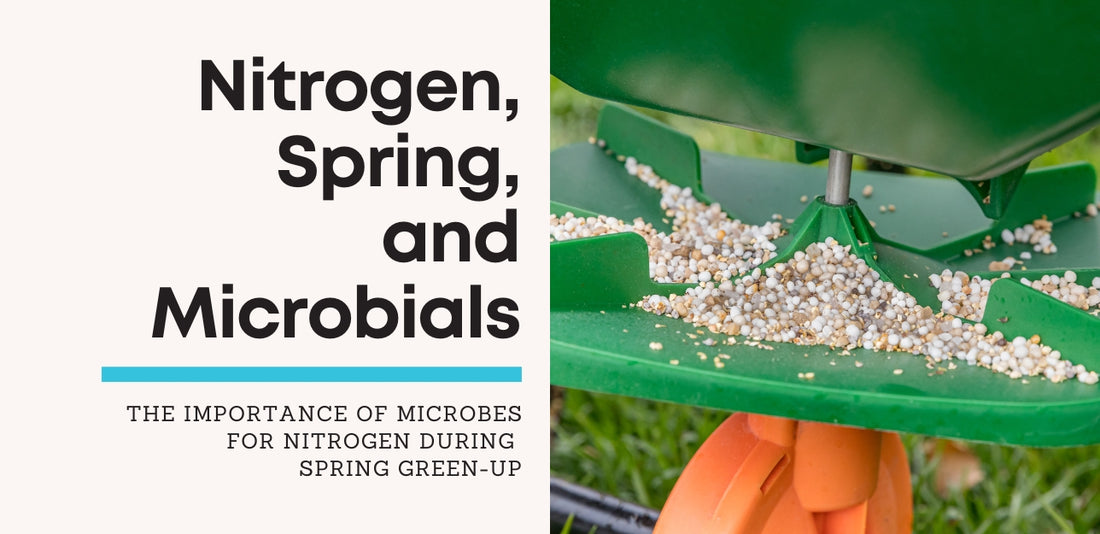
The Importance of Microbes for Nitrogen During Spring Green-Up
This blog can be found at the new En-Turf website: https://www.enturf.com/post/the-importance-of-microbes-for-nitrogen-during-spring-green-up
By Patricia Miller, PhDc & David Santos, MBiotech
Spring green-up is a critical period for turfgrass, marking the transition from dormancy to active growth. During this stage, grass heavily relies on nitrogen supply for an optimal transition. The primary role of microbes in facilitating nitrogen availability during this period is often overlooked. This blog post will delve into the importance of microbial involvement in nitrogen processes during the spring green-up, drawing insights from recent research advances and scientific literature.
Nitrogen, Plants and Microbes

Nitrogen is a vital nutrient for plant growth, and its availability can significantly influence the health and appearance of turf on golf courses. Microbes play a crucial role in the nitrogen cycle, converting atmospheric nitrogen into forms that plants and other organisms can absorb and use. This process, known as nitrogen fixation, is carried out by specific soil bacteria and endophytic bacteria (bacteria living within plant roots and tillers). In addition to nitrogen fixation, microbes also facilitate other processes in the nitrogen cycle, such as nitrification and denitrification. These processes help maintain the balance of different forms of nitrogen in the soil, ensuring that plants have access to the nutrients they need for growth and development. Endophytic bacteria (bacteria that live inside plant tissue) play a significant role as nitrogen delivery vehicles, supplying this nutrient directly to plant roots and tissues [1].
Stay ahead of the competition by subscribing to our email list. Be the first to know about microbials and turf! Subscribe
Spring Green-Up and Nitrogen

As temperatures rise between winter and spring, turfgrass emerges from winter dormancy and begins spring green-up. This is a complex process of internal versus external nitrogen absorption. New growth requires a significant amount of nitrogen, and grasses like bermudagrass and creeping bentgrass depend almost entirely on nitrogen stores found in roots and internodes from the fall season for this process. This occurs to rapidly deliver nitrogen for fast spring growth of new roots and tillers in the first two weeks of spring until these internal stores get depleted around day 10-14 [2]. External nitrogen fertilization only begins to be absorbed by grass at the end of this period. If fertilizer is applied too early, studies show that only 13% is absorbed, leaving the excess nitrogen as runoff. This excess nitrogen can also reduce microbial diversity in soil. In turn, less diverse microbial populations affect soil disease suppression; it reduces the pool of needed microbes that help the rhizosphere fight diseases like Dollar Spot, leaving turf more vulnerable. This reduced diversity can also result in nutrient stress during early growth and affect the supply of iron to plants, adding more stress [3]. Grasses inoculated with beneficial bacteria early in the season can supply needed nitrogen while scavenging otherwise bound soil iron, bridging the gap between internal and external nitrogen supplies for a faster green-up in the early spring, producing better quality, healthier and greener grass, all while improving soil microbial diversity [3, 4, 5].
Microbes and Golf Course Maintenance

For golf course superintendents, understanding the role of microbes in nitrogen cycling can inform maintenance practices. For example, practices that promote a healthy microbial community, such as proper irrigation and aeration, can enhance nitrogen availability by supplying atmospheric nitrogen to soil bacteria, improving spring green-up [6]. Furthermore, certain management practices can cause unwanted shifts in the microbial community and, thus, the nitrogen cycle. For instance, fungicides can create unwanted shifts in microbial populations on turfgrass foliage, impacting nitrogen cycling and other plant and soil biological processes [7]. Nitrogen fertilization in low water conditions, such as after winter desiccation or drought, has been implicated in reducing soil microbial diversity by causing a condition called 'cytotoxic dead zones' where bacteria experience toxicity in overly high concentrations of Nitrogen fertilizer, disrupting soil nutrient cycling. As we already know, it is a balance to ensure the right amount of watering during external nitrogen fertilization. But now, we must consider soil microbial communities while avoiding over-watering (that can cause nitrogen loss due to runoff) for a healthy turf and soil microbial diversity [4]. When water scarcity cannot be helped, microbial inoculants become essential, as they work to ease the drought stress on the grass by increasing root architecture and length to access water and nutrients more profound in the soil that would otherwise be unavailable. This, in turn, reduces the need to fertilize when conditions are dry, protecting both plant and soil microbial diversity and the subsequent disease pressure that occurs [5].
Conclusion

In conclusion, microbes play an essential role in the nitrogen cycle, helping to provide the nitrogen that turfgrass needs for spring green-up. By understanding this role, golf course superintendents and other turf managers can implement practices that support a healthy microbial community, promoting better nitrogen availability and cycling, resulting in a more vibrant green up in the spring and giving the grass the head start it needs for a healthier season.
Citations
[1] Camilios-Neto, D., Bonato, P., Wassem, R., Tadra-Sfeir, M. Z., Brusamarello-Santos, L. C. C., Valdameri, G., Donatti, L., Faoro, H., Weiss, V. A., Chubatsu, L. S., Pedrosa, F. O., & Souza, E. M. (2014). Dual RNA-seq transcriptional analysis of wheat roots colonized by Azospirillum brasilense reveals up-regulation of nutrient acquisition and cell cycle genes. BMC Genomics, 15(1), Article 378. https://doi.org/10.1186/1471-2164-15-378
[2] Sullins, K. N., Dillard, S. L., Held, D. W., & Carroll, E. P. (2023). Utility of plant growth-promoting rhizobacteria for sustainable production of bermudagrass forage. Microorganisms, 11(4), 863. https://doi.org/10.3390/microorganisms11040863
[3] Chou, M.-Y., Shrestha, S., Rioux, R., & Koch, P. (2021). Hyperlocal variation in soil iron and the rhizosphere bacterial community determines dollar spot development in amenity turfgrass. Applied and Environmental Microbiology, 87(10), e00149-21. https://doi.org/10.1128/AEM.00149-21
[4] De Luca, V., Gómez de Barreda, D., Lidón, A., & Lull, C. (2020). Effect of Nitrogen-fixing Microorganisms and Amino Acid-based Biostimulants on Perennial Ryegrass. HortTechnology, 30(2), 280-291. https://doi.org/10.21273/HORTTECH04236-19
[5] Ruiz, S. A., McKay Fletcher, D. M., Boghi, A., Williams, K. A., Duncan, S. J., Scotson, C. P., Petroselli, C., Dias, T. G. S., Chadwick, D. R., Jones, D. L., & Roose, T. (2020). Image-based quantification of soil microbial dead zones induced by nitrogen fertilization. Science of The Total Environment, 727, 138197. https://doi.org/10.1016/j.scitotenv.2020.138197.
[6] Hubbard, L. R., Jr., McCarty, L. B., Quisenberry, V. L., & Bridges, W. C. (2023). Aerification strategies affecting golf green subsurface properties. International Journal on Agriculture Research and Environmental Sciences, 4(1). https://skeenapublishers.com/journal/ijares/IJARES-04-00028.pdf
[7] Doherty, J. R., Botti-Marino, M., Kerns, J. P., Ritchie, D. F., & Roberts, J. A. (2017). Response of microbial populations on the creeping bentgrass phyllosphere to periodic fungicide applications. Plant Health Progress, 18(2), 44-49. https://apsjournals.apsnet.org/doi/10.1094/PHP-RS-16-0067
